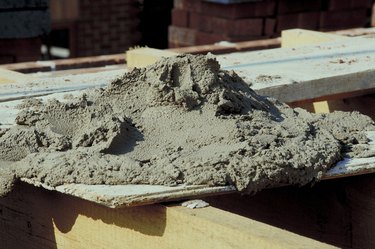
Mortar is the binding element for many installations, ranging from ceramic tile to natural stones, bricks and concrete blocks. In addition to acting as a mortar, the cement-based concrete can also be used as a grout to fill the joints between the pieces of individual material. The thickness requirements depend on the type of material you are working with, as each product has its own specifications.
Ceramic Tile
Video of the Day
As a general rule the finish thickness of thinset mortar with ceramic tile installations is around one eighth inch once the mud has been compressed under a tile. When it is combed on with the notched trowel it varies depending on the depth of the notch on the towel, but as the tile is pressed down into the mortar to bond it to the adhesive it squishes the mortar in place and smears it around the back of the tile.
Video of the Day
Natural Stone
Traditional natural stone installations have a wide variety of depths depending on the thickness of the stone. The basic method for installing natural stone is to shovel and pack in a roughly three-quarter inch thick base of material, after which the natural stones are tamped into place with a mallet or tamping machine. The finished mortar depth depends on the natural variances within the stones, but usually varies between a half inch and full inch of finish thickness.
Brick
Most bricks will have anywhere from a quarter inch to a half inch of mortar on the base level that the bricks are then set into, similar to blocks. For veneers it is the same as with ceramic tile, with the depth of the trowel defining the final thickness of the mud bed. Since cosmetic brick is usually in veneer form or installed in an area where it doesn't need structural support, the thickness will usually be an eighth inch to a quarter inch as defined by the trowel.
Load Bearing Blocks
If you are building block walls that are expected to bear a load (carry weight), such as with a foundation wall, you will need to check with your local building codes as to the exact requirements. Most block joints are between a third inch to a half inch in thickness, and this goes for the bed of mortar on the base where the block sits on top of the foundation layer. The bed is repeated between each row.